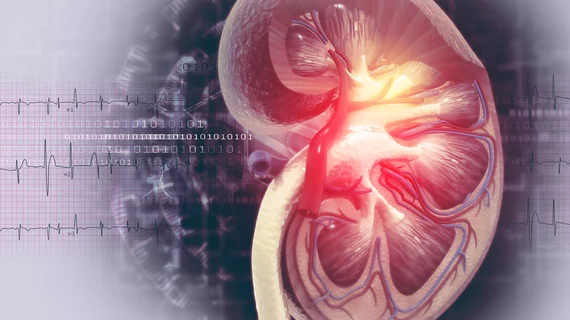Can patients with chronic kidney disease (CDK) safely undergo a transcatheter aortic valve replacement (TAVR) for severe aortic stenosis? Or is the risk too high that the procedure will make the patient’s CDK worse?
According to a new study published in the Journal of the American College of Cardiology, TAVR does not have a negative impact on a patient’s renal function. In fact, a patient’s CDK stage typically remains unchanged after TAVR—and sometimes, it even improves.
The authors explored data from more than 5,000 TAVR patients who received treatment from April 2007 to October 2014. The mean patient age was 84 years old, and all patients had severe aortic stenosis with a trileaflet aortic valve. Researchers included inoperable, high-risk and intermediate-risk patients in the study. In instances when the treatment changed from intended TAVR to another plan of action, including surgical aortic valve replacement, that patient’s data was excluded altogether.
Overall, CKD was common among TAVR patients, and CKD stage 2 or greater was present in 91% of patients. The CKD stage either improved or stayed the same seven days after TAVR in a vast majority of cases, including 99% of the time when the patient had CKD stage 4.
Also, the researchers noted, a higher pre-TAVR estimated glomerular filtration rate (eGFR) and transfemoral approach were both “strongly associated” with higher post-TAVR eGFR.
“The current study provides practical guidance and reassurance to physicians of patients with CKD reluctant to undergo TAVR due to concerns for worsening kidney function during the procedure,” wrote lead author Robert J. Cubeddu, MD, of Cleveland Clinic Weston in Weston, Florida, and colleagues.
A separate editorial, also published in the Journal of the American College of Cardiology, reviewed the topic of TAVR and CKD at length. The authors praised the work of Cubeddu as “insightful,” noting how it compares with prior studies.
“The novel conclusion that TAVR is likely to stabilize or improve renal function in patients with CKD seems inconsistent with prior studies of exclusively higher surgical risk CKD patients undergoing TAVR that demonstrated a greater degree of worsening post-procedure kidney function,” wrote lead author Benjamin Z. Galper, MD, MPH, of Mid-Atlantic Permanente Medical Group in McLean, Virginia, and colleagues. “However, the findings of Cubeddu et al. are consistent with a recent meta-analysis that found CKD to be associated with increased mortality and poorer overall outcomes only in high-risk patients undergoing TAVR, but not in intermediate- and low-risk patients. This observation suggests that the interaction between CKD and poor TAVR outcomes is less pronounced in lower surgical risk patients. Of note, although the present study included patients with a broad range of surgical risk, it did not stratify outcomes by surgical risk level.”
The team behind the editorial also emphasized a point made in the original study—that these findings should help make patients and physicians alike less reluctant to consider TAVR as a treatment option if the patient has a history of CKD.
“The findings of this study will influence shared decision-making between CKD patients and the heart team,” Galper and colleagues added.
The full analysis from Cubeddu and colleagues is available here.

